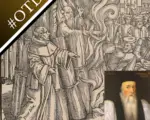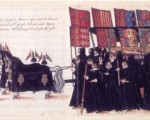
On this day in Tudor history, 24th March, judge and Speaker of the House of Commons, Sir James Dyer, died; Queen Elizabeth I died at Richmond Palace; and Robert Rich, Earl of Warwick, died…
[Read More...]
On this day in Tudor history, 24th March, judge and Speaker of the House of Commons, Sir James Dyer, died; Queen Elizabeth I died at Richmond Palace; and Robert Rich, Earl of Warwick, died…
[Read More...]
On this day in Tudor history, 21st March, Puritan Sir John Leveson, a man who helped put down Essex’s Rebellion, was born; Archbishop Cranmer was burnt at the stake in Oxford for heresy; and a dying Elizabeth I took to her bed…
[Read More...]
On this day in Tudor history, 21st March 1603, a dying Queen Elizabeth I finally took to her bed.
Elizabeth I had been queen since November 1558, but now she was dying. She had deep-rooted melancholy, couldn’t sleep and was refusing to eat. She spent her days lying on cushions in her withdrawing chamber. But on 21st March, she was finally persuaded to go to bed.
Find out more about these last days in this talk.
[Read More...]
On this day in history, the 24th March 1603, Queen Elizabeth I died at Richmond Palace aged 69, bringing the rule of the Tudor dynasty to an end. Elizabeth I had reigned for 44 years and 127 days and her reign was known as “The Golden Age”. She was the longest reigning Tudor monarch.
It is said that the execution of her former favourite, Robert Devereux, the Earl of Essex, on the 25th February 1601 had a huge impact on Elizabeth. She had already lost her great love Robert Dudley in 1588, her good friend Blanche Parry in 1590, and her friend and adviser William Cecil, Lord Burghley, in 1598. It seemed that all those she loved and depended on were dying and leaving her. Her grief, combined with a belief that she was losing her grip on her court and country, led to her becoming severely depressed.
[Read More...]
“It is not my desire to live or to reign longer than my life and my reign shall be for your good,” said Elizabeth to her parliament in 1601. Upon one of the many times parliament questioned Elizabeth about her plan of succession, she stated, “I know I am but mortal and so therewhilst prepare myself for death, whensoever it shall please God to send it.” And send it, God eventually did.
24 March, 1603. Elizabeth I, the Virgin Queen, England’s Gloriana and daughter of the great Henry VIII by the ill-fated Anne Boleyn, passed away peacefully in her sleep at Richmond Palace. She was 69 years old and had reigned for almost 45 years.
[Read More...]
Elizabeth I is one of England’s most well-known monarchs. She was the daughter of the infamous King Henry VIII and his second wife the illustrious Queen Anne Boleyn, who was executed when Elizabeth was just two years old.
Elizabeth reigned for almost forty-five years and was the last monarch of the Tudor Dynasty, having died childless. Her reign is famous as ‘The Golden Age’, for its blooming of the arts with the origins of Renaissance drama and for producing the most famous playwrights of the era, such as William Shakespeare and Christopher Marlowe.
[Read More...]